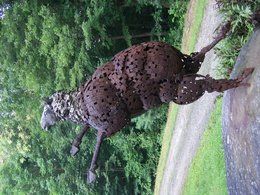 One of the blessings in Connecticut is the presence of Abbey of Regina Laudis, a monastery of nearly 40 Benedictine nuns in the hills of Litchfield, County (in the Archdiocese of Hartford). Looking out in the choir there were 5 white veil novices and 1 postulant among the other professed nuns.
One of the blessings in Connecticut is the presence of Abbey of Regina Laudis, a monastery of nearly 40 Benedictine nuns in the hills of Litchfield, County (in the Archdiocese of Hartford). Looking out in the choir there were 5 white veil novices and 1 postulant among the other professed nuns.
I went to the abbey with Father Ignacio today so that he could celebrate the Sacrifice of the Mass for the nuns since they are without a resident chaplain. Father Ignacio is a newly ordained priest of the Bridgeport Diocese currently serving at Saint Rose of Lima Church (Newtown, CT). Mass at the abbey follows the Mass of Pope Paul VI, also called the Novus Ordo (the new Order [Mass]). Often Mass is celebrated using the Latin language except for the Scripture readings and homily. However, the Mass is often in English with the Latin chants.
Like a number of monasteries and convents the sisters are without a resident priest these days. And you can guess the reasons for this. The abbey’s past chaplain, a Benedictine monk, transfered his vow of stability from his abbey of profession to another. Thus, he had to move to his new abbey.
I was happy to be at Regina Laudis again after being away for 2 years. This time was especially happy because I was able to meet Mother Placid again after 9 years (I don’t usually call on the nuns for a visit when I stop in for a visit to the bookstore and chapel). Mother Placid is the first American vocation to stay at the Abbey with the foundress, Lady Abbess Benedict. As Providence would have it, I greeted the mother of a former student. And from a distance I saw a former classmate from the seminary. Amazing who one meets at a bucolic Benedictine monastery.
As a side note, the nuns are land based. Meaning, they farm the land by raising vegetables, tending the forest, raising a beef herd for local consumption and dairy cattle for the abbey’s use. Many of the nuns are professionally trained in the various sciences to assist in the proper use of the land. The good and proper use of the land is a particularly Benedictine characteristic. The nuns tend to the beauty of creation as a theological statement of belief in the Incarnation.

Additionally, the abbey has through the years attracted women from all walks of life and pedigree: some have been lawyers, physicians, artists, poets, actresses, theologians, minor nobility and the like. Mother Foundress’ leadership and vision was the result of the integration of faith and reason. She knew deeply the Catholic tradition of the religious, artistic and intellectual life. Hers was a monastic life that is virtually unknown in the United States. Regina Laudis is likely one of 4 or 5 similar monasteries of women. Historically, Mother Benedict knew personally Popes Pius XII, John XXIII and Paul VI and all of them encouraged the Foundress to keep alive Benedictine culture, ecumenism, the Latin chants and the intellect (that is, if a woman came to the abbey is a professional credential, or later earned one, she was keep current in that field).
 You know from a previous post here that Mother Dolores Hart, OSB, nun of the Abbey of Regina Laudis (Bethlehem, CT) published her autobiography, The Ear of the Heart: An Actress’ Journey From Hollywood to Holy Vows (Ignatius Press, 2013). The book is co-authored with lifelong friend Richard DeNeut. There was a book signing this past Sunday.
You know from a previous post here that Mother Dolores Hart, OSB, nun of the Abbey of Regina Laudis (Bethlehem, CT) published her autobiography, The Ear of the Heart: An Actress’ Journey From Hollywood to Holy Vows (Ignatius Press, 2013). The book is co-authored with lifelong friend Richard DeNeut. There was a book signing this past Sunday.







